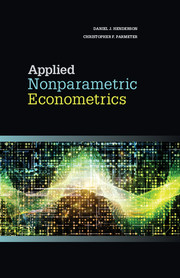Book contents
- Frontmatter
- Dedication
- Contents
- 1 Introduction
- 2 Univariate density estimation
- 3 Multivariate density estimation
- 4 Inference about the density
- 5 Regression
- 6 Testing in regression
- 7 Smoothing discrete variables
- 8 Regression with discrete covariates
- 9 Semiparametric methods
- 10 Instrumental variables
- 11 Panel data
- 12 Constrained estimation and inference
- Bibliography
- Index
10 - Instrumental variables
Published online by Cambridge University Press: 05 February 2015
- Frontmatter
- Dedication
- Contents
- 1 Introduction
- 2 Univariate density estimation
- 3 Multivariate density estimation
- 4 Inference about the density
- 5 Regression
- 6 Testing in regression
- 7 Smoothing discrete variables
- 8 Regression with discrete covariates
- 9 Semiparametric methods
- 10 Instrumental variables
- 11 Panel data
- 12 Constrained estimation and inference
- Bibliography
- Index
Summary
Many situations in applied econometric work require knowledge of a structural or causal relationship in order to guide policy recommendations. Aside from possessing valid instrumental variables to correctly capture endogeneity, uncovering the structural relationship of interest usually requires specifying a utility or cost function or the distribution of preferences in order to derive a reduced form model that can be estimated. Unfortunately, this route is unappealing, as it is uncommon to know the underlying distribution or specification of the model primitives necessary for deriving the corresponding reduced form. Moreover, economic theory rarely provides tight correspondence between the model primitives and their functional forms. However, turning directly to a nonparametric approach has not been a common choice among empiricists, as the methods necessary to provide consistent estimates in the face of endogeneity have only recently been developed and may present complications for implementation (see Newey, Powell, and Vella, 1999; Pinske, 2000; Newey and Powell, 2003; Horowitz and Hall, 2005; Su and Ullah, 2008; and Darolles, Fan, Florens, and Renault, 2011; Martins-Filho and Yao, 2012; Ozabaci, Henderson, and Su, 2014).
A key difficulty with the implementation of instrumental variable nonparametric methods is that, in their most general form, they require inversion of an integral equation, and this inversion does not represent a continuous mapping: the so-called ill-posed inverse problem. Thus, the typical analog estimation routines (replacing population expectations with sample ones) that we have seen in previous chapters are unlikely to work here. That is, replacing an unknown (smooth) mean with a sample analog will not guarantee consistent estimation of the object of interest in this setting. One approach to avoiding the ill-posed inverse problem is to use a control function approach. From an applied standpoint, the control function approach produces estimators that are easier to implement in practice.
In this chapter, we outline the inherent difficulty induced by endogeneity in a non-parametric framework. We then discuss why a control function approach is suitable for dealing with endogeneity.
Information
- Type
- Chapter
- Information
- Applied Nonparametric Econometrics , pp. 267 - 292Publisher: Cambridge University PressPrint publication year: 2015
